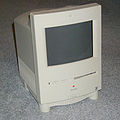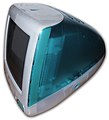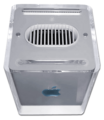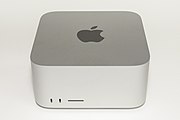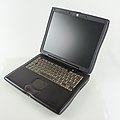
The Power Macintosh, later Power Mac, is a family of personal computers designed, manufactured, and sold by Apple Computer, Inc. as the core of the Macintosh brand from March 1994 until August 2006.

Xserve is a line of rack unit computers designed by Apple Inc. for use as servers. Introduced in 2002, it was Apple's first designated server hardware design since the Apple Network Server in 1996. In the meantime, ordinary Power Macintosh G3 and G4 models were rebranded as Macintosh Server G3 and Macintosh Server G4 with some alterations to the hardware, such as added Gigabit Ethernet cards, UltraWide SCSI cards, extra large and fast hard drives etc. and shipped with Mac OS X Server software. The Xserve initially featured one or two PowerPC G4 processors, but later switched over to the then-new PowerPC G5, transitioned to Intel with the Core 2-based Xeon offerings and subsequently switched again to two quad-core Intel Nehalem microprocessors.

Macintosh Centris is a family of personal computers designed, manufactured and sold by Apple Computer, Inc. in 1992 and 1993. They were introduced as a replacement for the six-year-old Macintosh II family of computers; the name was chosen to indicate that the consumer was selecting a Macintosh in the center of Apple's product line. Centris machines were the first to offer Motorola 68040 CPUs at a price point around US$2,500, making them significantly less expensive than Quadra computers, but also offering higher performance than the Macintosh LC computers of the time.
Apple Inc. sold a variety of LCD and CRT computer displays in the past. Apple paused production of their own standalone displays in 2016 and partnered with LG to design displays for Macs. In June 2019, the Pro Display XDR was introduced, however it was expensive and targeted for professionals. Nearly three years later, in March 2022, the Studio Display was launched as a consumer-targeted counterpart to the professional monitor. These two are currently the only Apple-branded displays available.
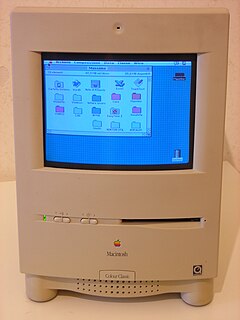
The Macintosh Color Classic is a personal computer designed, manufactured and sold by Apple Computer, Inc. from February 1993 to May 1995. It has an "all-in-one PC" design, with a small, integrated 10″ Sony Trinitron display at 512 × 384 pixel resolution. The display is capable of supporting up to thousands of colors with a video memory upgrade.

The Apple Cinema Display is a line of flat-panel computer monitors developed and sold by Apple Inc. between 1999 and 2011. It was initially sold alongside the older line of Studio Displays, but eventually replaced them. Apple offered 20, 22, 23, 24, 27 and 30-inch sizes, with the last model being a 27-inch size with LED backlighting.

The Macintosh IIvx is a personal computer designed, manufactured and sold by Apple Computer from October 1992 to October 1993. It is the last of the Macintosh II family of Macintosh computers. The IIvx was introduced at the same time as the Macintosh IIvi, Performa 600 and Performa 600CD, with all four models using the same new metal case design. Like the Performa 600CD, the IIvx could be equipped with an internal double-speed CD-ROM drive.
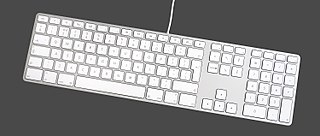
Apple Inc. has designed and released dozens of keyboard models since the introduction of the Apple II in 1977. The current models in use are dual-mode keyboards with integrated batteries: Magic Keyboard, and Magic Keyboard with Numeric Keypad. Both share a similar look and feel, based on a very thin aluminum chassis and laptop-style low-profile keys, sitting much closer to the tabletop than traditional keyboard designs.

The MacBook Pro is a line of Macintosh notebook computers by Apple Inc. Introduced in January 2006, it is the higher-end model of the MacBook family, sitting above the consumer-focused MacBook Air. It is currently sold with 13-inch, 14-inch, and 16-inch screens, all using variants of the Apple-designed M1 and M2 system on a chip.

The MacBook is a line of Macintosh notebook computers designed, manufactured and sold by Apple Inc. from May 2006 to February 2012. A new line of computers by the same name was released in 2015, serving the same purpose as an entry-level laptop. It replaced the iBook series of notebooks as a part of Apple's transition from PowerPC to Intel processors. Positioned as the low end of the MacBook family, below the premium ultra-portable MacBook Air and the powerful MacBook Pro, the MacBook was aimed at the consumer and education markets. It was the best-selling Macintosh ever. For five months in 2008, it was the best-selling laptop of any brand in US retail stores. Collectively, the MacBook brand is the "world's top-selling line of premium laptops."

The Macintosh Quadra 605 is a personal computer designed, manufactured, and sold by Apple Computer, Inc. from October 1993 to July 1996. The model names reflect a decision made at Apple in 1993 to follow an emerging industry trend of naming product families for their target customers – Quadra for business, LC for education, and Performa for home. Accordingly, the Performa 475 and 476 was sold in department stores and electronics stores such as Circuit City, whereas the Quadra was purchased through an authorized Apple reseller.

The Macintosh Quadra 630 is a personal computer designed, manufactured and sold by Apple Computer, Inc. from July 1994 to October 1995. It was introduced as the replacement for the Quadra 610, and was the least-expensive computer in the Macintosh lineup with prices starting at $1,199 USD.
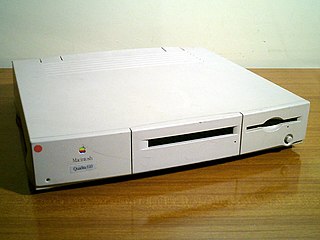
The Macintosh Quadra 610, originally called the Macintosh Centris 610, is a personal computer designed, manufactured and sold by Apple Computer from February 1993 to July 1994. The Centris 610 was introduced alongside the larger Centris 650 as the replacement for the Macintosh IIsi, and it was intended as the start of the new midrange Centris line of computers. Later in 1993, Apple decided to follow an emerging industry trend of naming product families for their target customers – Quadra for business, LC for education, and Performa for home – and folded the Centris 610 into the Quadra family.

The Intel-based iMac is a discontinued series of Macintosh desktop computers designed, manufactured and sold by Apple Inc. from 2006 to 2022. While sold, it was one of three desktop computers in the Macintosh lineup, serving as an all-in-one alternative to the Mac Mini, and sat below the performance range Mac Pro. It was sold alongside the Xeon-based iMac Pro from 2017 to 2021.

The MacBook is a brand of Macintosh notebook computers designed and marketed by Apple Inc. that use Apple's macOS operating system since 2006. It replaced the PowerBook and iBook brands during the Mac transition to Intel processors, announced in 2005. The current lineup consists of the MacBook Air (2008–present) and the MacBook Pro (2006–present). Two different lines simply named "MacBook" existed from 2006 to 2012 and 2015 to 2019.

The Macintosh is a family of personal computers designed, manufactured, and sold by Apple Inc. since January 1984.

iMac is a family of all-in-one Macintosh desktop computers designed and built by Apple Inc. It has been the primary part of Apple's consumer desktop offerings since its debut in August 1998, and has evolved through seven distinct forms.
The classic Macintosh startup sequence includes hardware tests which may trigger the startup chime, Happy Mac, Sad Mac, and Chimes of Death. On Macs running macOS Big Sur the startup sound is enabled by default, but can be disabled by the user within system preferences.
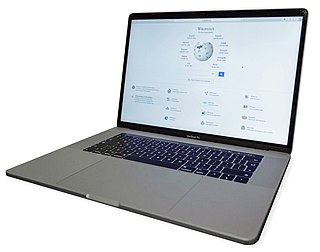
The Intel-based MacBook Pro is a discontinued line of Macintosh notebook computers sold by Apple Inc. from 2006 to 2021. It was the higher-end model of the MacBook family, sitting above the consumer-focused MacBook Air, and was sold with 13-inch to 17-inch screens.




